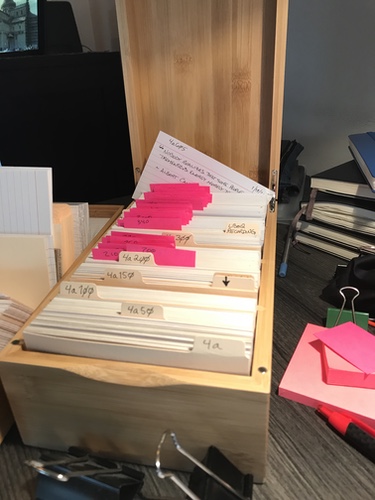Pick two
Pick any two ideas, presume they are connected, and present that connection as a question.
I’ll wager you’re thinking, “that’s easier read than done.” But, it is easy. Simply ask:
Is there a connection between X and Y?
Exercise: Pause here and think of a few random pairs of ideas. The faster you pull the ideas out, the better. Take two ideas and say the question in your mind. Are they not surprising, the trains of thought which spring up? If you manage to stump yourself in finding a connection, would it have been an interesting exchange if another person had been involved?
Where’s the trick?
The trick is right there in the very first line I wrote, in the first phrase:
Pick two ideas.
The two ideas are connected; that’s how your mind was able to pick them. The trick uses your mind’s built-in super-powers of observation and curiosity. To ask a great question, people focus on finding a question. It’s far easier to make a question out of something great.
Clearly the degree of greatness of your question depends on what ideas you pick. Fortunately, the more you pick-two and ask about the connection, the better you’ll get at picking better ideas. You’re refining your mental observation skills and refining your taste in which ideas will combine into a great question.
Complications
In mechanical watches, a “complication” is some additional function. Indicating the day of the week, the date, or the phase of the moon, are in reality not that different in terms of complexity; They are each simply a complication. It’s the total number of complications that impresses the watch aficionados.
I’m going to throw a bunch of complications on top of this idea. By analogy with the watches, I’m suggesting that no one of these is any better or more complex. Each complication is simply a possibility you could add. One of your goals, in any conversation I care to think about, is to have your tools and skills disappear in service of the conversation. Only through experience can you learn how complicated to make things. It varies based on every conversational parameter you can imagine. Sometimes, the barest simplicity is the best choice—“is there a connection between X and Y?”—and sometimes…
It’s not you, it’s me. If the question you’re posing might be too personal, taboo, etc. you can couch it in a dash of self-deprecation. “I know this sounds weird, but is there a connection between X and Y?” Your conversation partner can easily parry—in fact, people will automatically and subconsciously parry this way if they are uncomfortable—with, “Yes that’s weird. What sort of wacko would ask that?” Being a great conversationalist, you can then proceed in another direction. (Or press on!)
The joy of wonder. Rare, (and possibly psychotic,) is the person who isn’t sucked in when you express honest wonder. If you really are wondering—that is probably how you picked those two ideas in the first place—then it’s going to be obvious that you’re enjoying asking about the connection. “Oh, wow! Now I’m wondering if there’s a connection between X and Y.”
Grammar ain’t all that. Did you catch that? That last example wasn’t a question. Turns out, it’s not necessary to speak a grammatical question. All you ever need to do is convey that you have a question. In the Movers Mindset podcast I get endless mileage out of saying, “And of course, the final question: Three words to describe your practice.” Which is a statement stapled to a sentence fragment, and I don’t even pitch-up at the end to make it sound like a question. Statements using “wondering” are the obvious way to do statement-questions. But there are more: “I’m astounded I never realized there’s a connection between X and Y.” That one has a quiet little question—“is there actually a connection here?”—tucked in under the loud astonishment. There’s also, “I can’t believe I never noticed the connection between X and Y.” Even snarky, “…next you’re going to tell me X and Y are connected.” Complications sure, but filigree has its place.
There can’t possible be more
I’ve described this entire thing as if it were something you do once, (and then use the question.) Eventually, you can generate two, sometimes three or more, two-ideas-and-a-connection questions before the pause gets pregnant. With practice, you can regularly generate 2, and then choose the one you like better.
This is particularly important if you’re trying to lead the conversation—“lead” as in “let’s go for a stroll and I secretly want to show you my favorite bakery along the way,” not “I want to lead you to a mugging”. Being able to ask great questions is one thing, but being able to ask a series of great questions that lead to a through-line, however tenuous, is pure wizardry.
ɕ
